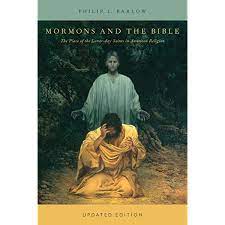Articles/Essays – Volume 25, No. 4
Measuring the Measuring Stick | Philip L. Barlow, Mormons and the Bible: The Place of the Latter-day Saints in American Religion
Even with the explosion of scholarly interest in Mormonism over the past fifteen years, students of American religion still wait for a systematic and synthetic treatment of the development of Mormon theology. Central to such an endeavor would be an analysis of the place and use of the Bible in Mormonism, a topic which has received far too little attention. With considerable success, Philip Barlow’s book attempts to correct this deficiency.
Barlow sets out to study Mormon biblical usage by asserting that nothing “captures the evolving but enduring religious quintessence of Mormonism and its relationship to the balance of American religion better than a firm, comparative grasp of the Bible’s place among the Latter-day Saints” (p. xi). He goes about his analysis by focusing on a series of key individuals “who have had particular impact on Mormon scriptural conceptions and who have themselves reflected major LDS tendencies” (p. xiii). Barlow is well aware of the strengths and weaknesses of his approach. While examining key figures gives a focus to his study, his analysis does not explore issues of ethnicity, nativity, class, or gender.
Barlow begins his study by discussing the place of the Bible in antebellum culture, then examines Mormonism’s use of the Bible from 1820 to 1844 by turning to the prophet Joseph Smith. For the second half of the nineteenth century, he looks at Brigham Young and Orson Pratt. Moving into the twentieth century, Barlow focuses next on higher criticism and Mor monism, looking at B. H. Roberts, Joseph Fielding Smith, and William H. Chamberlain, then completes his study with Bruce R. McConkie, Lowell L. Bennion, and the Bible in contemporary Mormon culture.
Barlow makes a forceful case for biblical interpretation being a more flexible and dynamic process in early Mormon ism when Smith, Young, and Pratt exercised what he calls “a selective literalism” (p. 32). What set Mormons apart—as exemplified by these leaders—was their ability to select which parts of the Bible they would take literally. They chose to determine God’s truth not only by turning to the Bible, but by looking at other forms of both written and oral revelation. Smith, Young, and Pratt had deep misgivings about the ability of human language to capture God’s thoughts. Words were too small to convey omniscience. Thus, a more flexible view of scripture and its interpretation were early marks of the Mormon attitude toward the Bible.
Central to Barlow’s work is his analysis of the Bible as a measuring stick to help determine the place of the Latter-day Saints in American religion. He argues that Mormons have always been “Bible believers,” but their use of the Bible places them somewhere between Timothy Smith’s view that Mormons are essentially part of the religious “mainstream” and Jan Shipps’ argument that Mormonism represents a genuinely new religious tradition. Barlow asserts that while Latter-day Saints have long maintained “a traditional faith in the Bible with more ‘conservative’ elements,” they are unique in the American context in the way they combine their use of the Bible with more radical elements of divine revelation, such as belief in an open canon, oral scriptures, and the role of living prophets (pp. 227, 28).
Perhaps the most enlightening part of Barlow’s study is his analysis of the twentieth-century trend in Mormonism toward a conservative view of scriptural interpretation. By coupling a wealth of personal interviews with a breadth of primary and secondary source research, Barlow argues that a conservative Mormon leadership has outmaneuvered more liberal voices in the Church’s power structures when it comes to issues of biblical interpretation. He explores this line of reasoning by discussing Mormonism’s relationship to a number of scriptural, as well as non-scriptural, printed works. By looking at the role of books such as Bruce McConkie’s Mormon Doctrine, the King James Version of the Bible, and the new LDS edition of the scriptures, Barlow shows that even though these texts lack an official Church imprimatur, their wide use places them as crucial agents of influence on Mormon theological thinking.
Barlow’s work has its weaknesses. It has an expensive price tag for a book which is some 250 pages long and has a pen chant for generalities. The general nature of the book comes out most clearly in its first three chapters, where the use and analysis of primary source material is uneven and the terminology he employs could often benefit from greater definition. Frequently the text leaves the reader with questions. For example, when Barlow compares the Mormons to “Evangelical Christians” in chapter two, he never specifies which denominations he means (p. 68). Nineteenth-century Protestantism was not monolithic in nature. There are also some bothersome inaccuracies. For instance, the parting of the Red Sea occurs in Exodus. Barlow attributes the event to Genesis (p. 34).
Despite these weaknesses, Barlow’s study is well worth reading. It is a lucidly written, thoughtful treatment of a large and unwieldy topic. His observations and analysis, as well as his insight into the limits of his own work and the possibilities for future investigations, make this book a welcome addition to the history of Mormon theology.
Mormons and the Bible: The Place of the Latter-day Saints in American Religion by Philip L. Barlow (New York: Oxford University Press, 1991), 251 pp., select bibliography, index, pictures, $34.95.


 Back to full Issue
Back to full Issue

